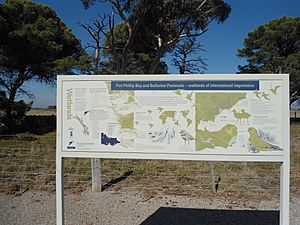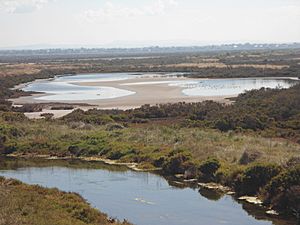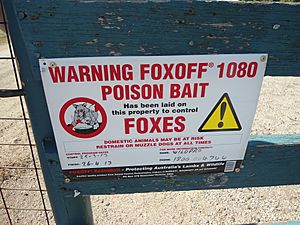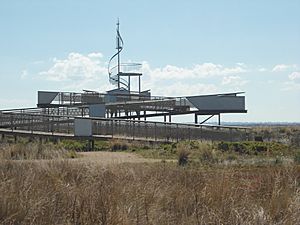Cheetham Wetlands facts for kids
The Cheetham Wetlands is a special place in Australia. It's a big area of 420 hectares (that's about 1,000 acres!) with both natural and man-made lagoons. These lagoons were created on land that used to be a salt works, where people collected salt from seawater.
You can find the Cheetham Wetlands on the western side of Port Phillip Bay, about 20 kilometers (12 miles) southwest of Melbourne. It's located within the areas of Hobsons Bay and Wyndham City.
This important wetland is part of the Point Cook Coastal Park. It's protected land, meaning it's set aside for conservation. Different groups like the Department of Sustainability & Environment and Melbourne Water help manage it. Parks Victoria also looks after the northern part. The Cheetham Wetlands are so important that they are protected by an international agreement called the Ramsar Convention. This convention helps protect wetlands around the world.
Contents
Why are Cheetham Wetlands important?
The Cheetham Wetlands used to be a natural salt marsh and woodland area. Later, it became a saltworks. This is how the lagoons were formed. These lagoons are now a magnet for many different kinds of birds. In 1996, the land was officially protected. This was done to save the wetland system and all the amazing plants and animals that live there. This includes many migratory birds that travel long distances.
How do the wetlands work?
Even though parts of the Cheetham Wetlands were made by people, they work like natural wetlands. They are very important for keeping the area healthy. Wetlands help in many ways:
- They help refill or empty underground water supplies.
- They clean water naturally.
- They store water.
- They recycle important nutrients.
- They help keep the shoreline stable.
- They trap dirt and sand.
Amazing Animals of the Wetlands
The Cheetham Wetlands are home to over 200 types of birds! Many of these birds visit every year. A lot of them breed in the Northern Hemisphere during their summer. Then, they fly all the way to the Southern Hemisphere between July and November. The most birds are seen in the Point Cook Coastal Park area from September to March.
The wetlands are especially important for many bird species, including:
- Red-necked stint
- Red-necked avocet
- Sharp-tailed sandpiper
- Double-banded plover
- Common greenshank
- Marsh sandpiper
- Curlew sandpiper
- Orange-bellied parrot
- Fairy tern
- Common tern
- Yellow sedge-skipper (this is a type of butterfly!)
Threats to the Wetlands
Wetlands around the world are facing many dangers. The Cheetham Wetlands are no different. They are threatened by both natural problems and things caused by people.
Growing Cities
One big threat is that cities are growing closer to the wetlands. The nearby area of Wyndham City is expanding very quickly. More houses and buildings mean changes to the natural areas like Point Cook Coastal Park and Cheetham Wetlands.
Water Quality Problems
The water in the wetlands is also at risk. Things like storm water runoff, pollution, and trash can make the water dirty. The water levels in the wetlands are controlled by pumps. It's very important to manage these pumps correctly. If too much dirty storm water is pumped in, it can bring in dirt and pollution.
Pests and People
Other threats come from human activities. When people bring pets into the area or use it for recreation, it can disturb the birds and their homes. There are also problems from introduced animals like feral cats, foxes, and rabbits. These animals can harm the native wildlife.
Protecting the Wetlands
Because Cheetham Wetlands is such an important natural area, many plans are in place to protect it.
Conservation Programs
Here are some of the things being done to help:
- Melbourne Water and Hobson’s Bay Council have planted native plants along a 4-kilometer (2.5-mile) stretch of land. This helps connect habitats and gives native animals more places to live and hide from pests.
- The wetlands were part of a project called "Revive our Wetlands." This project helped get the community involved in conservation. It also worked to restore habitats, improve water quality, reduce litter, and record wildlife.
- Efforts have been made to help the natural salt marsh grow back. They have also planted Thatching grass, which is important for the Yellow Sedge-Skipper butterfly. They removed a harmful weed called boxthorn that competes with the grass.
- The Shorebird Conservation Project helps people understand and get involved in protecting shorebird habitats.
- The Ramsar Protection Plan helps control weeds and feral animals. As part of this plan, 200 hectares (about 500 acres) of the wetlands will get rabbit-proof fencing.
- The River Health Program works to improve water quality flowing into the bay.
Benefits of Management
The ways the wetlands are managed help protect them. For example, access to some areas is limited to walking only. There are special walking tracks and viewing decks. This helps make sure the animals' homes are not disturbed. Studies have shown that some people still go into restricted areas, especially during holidays. So, more signs have been put up, and patrols happen during busy times.
Listing the site as a Ramsar wetland is a big help. It means any new building plans must go through a careful review process. There's also a special plan for Port Phillip Bay and the Bellarine Peninsula. This plan identifies threats and suggests ways to fight them.
Managing the water in the wetlands is also key. Water is pumped in from Skeleton Creek. In the late 1980s, when pumping stopped for two years, the number of waterbirds dropped by 85%! When pumping started again, the birds quickly returned.
All these conservation programs help the unique plants and animals that live here. This is especially true for the Orange-Bellied Parrot and the Yellowish-Sedge Skipper, which are both critically endangered.





